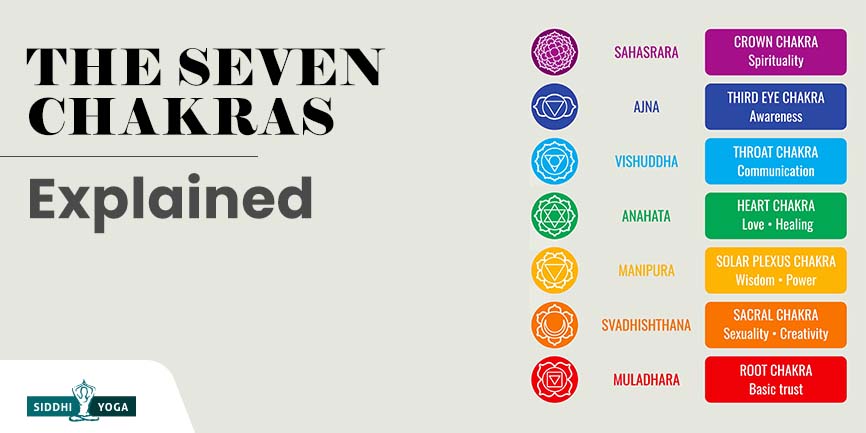
The human body has seven main chakra or energy centres. Each chakra governs a different area of your body and mind. In this article, we will explore the importance and relevance of each chakra.
Introduction
Chakra is a Sanskrit word that means “wheel” or “turning” and refers to your body’s energy centers. The chakras as wheels within us, symbolizing the flow of energy. Their significance is described as both an emotional regulating system and a consciousness gateway to higher understanding through meditative and yogic practices.
The seven major chakras located throughout your body control different aspects of your life, including mind over matter (located at the top of your head), creativity generator (at your chest), spiritual guidance and connection between self and the cosmos (between your eyebrows).
These seven chakras are also responsible for your physical, mental, and emotional well-being. When they are balanced, you feel healthy, happy and wholesome.
The chakra system is often represented as a lotus flower with seven petals, each representing one of the seven main chakras. The lotus flower itself is a symbol of purity and divine beauty. Just as the lotus flower grows from the mud below to the surface of the water, so does the soul grow from the lowest chakra to the highest, reaching up to the light of the Divine.
The chakras are an important part of Hindu and Buddhist traditions, with their earliest historical references going as far back as 3000 BC
The Seven Chakras:
1. The Root Chakra (Muladhara)
2. The Sacral Chakra (Svadhisthana)
3. The Solar Plexus Chakra (Manipura)
4. The Heart Chakra (Anahata)
5. The Throat Chakra (Visuddha)
6. The Third Eye Chakra (Ajna)
7. The Crown Chakra (Sahasrara)
Let’s explore each chakra’s unique purpose, meaning, associated color, element, and qualities.
The Root Chakra (Muladhara)
The Root Chakra, or Muladhara in Sanskrit, is the first chakra located at the base of your spine. This chakra is associated with your feelings of safety and security. It is foundational to your body and mind’s health and is responsible for your survival instinct.
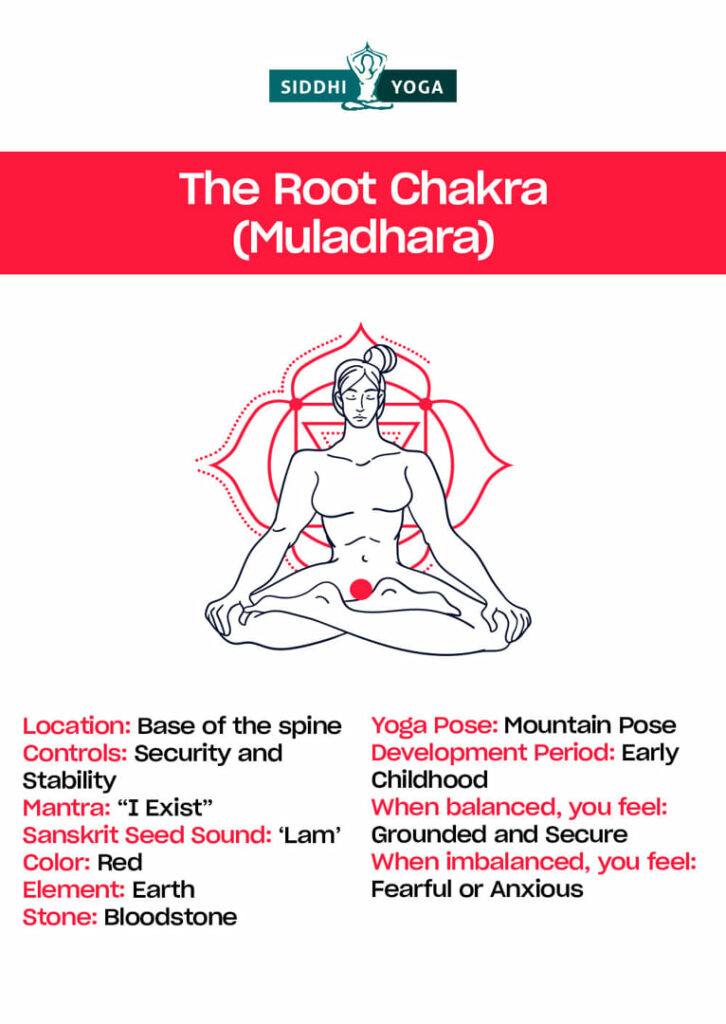
- Location: Base of the spine
- Controls: Security and Stability
- Mantra: “I Exist”
- Sanskrit Seed Sound: ‘Lam’
- Color: Red
- Element: Earth
- Stone: Bloodstone
- Yoga Pose: Mountain Pose
- Development Period: Early Childhood
- When balanced, you feel: Grounded and Secure
- When imbalanced, you feel: Fearful or Anxious
The Sacral Chakra (Svadhisthana)
The Sacral Chakra is the second chakra located just below your navel. This chakra is associated with pleasure, creativity, and sexuality. It is the center of your emotions and desires, and it governs your ability to feel pleasure and pain
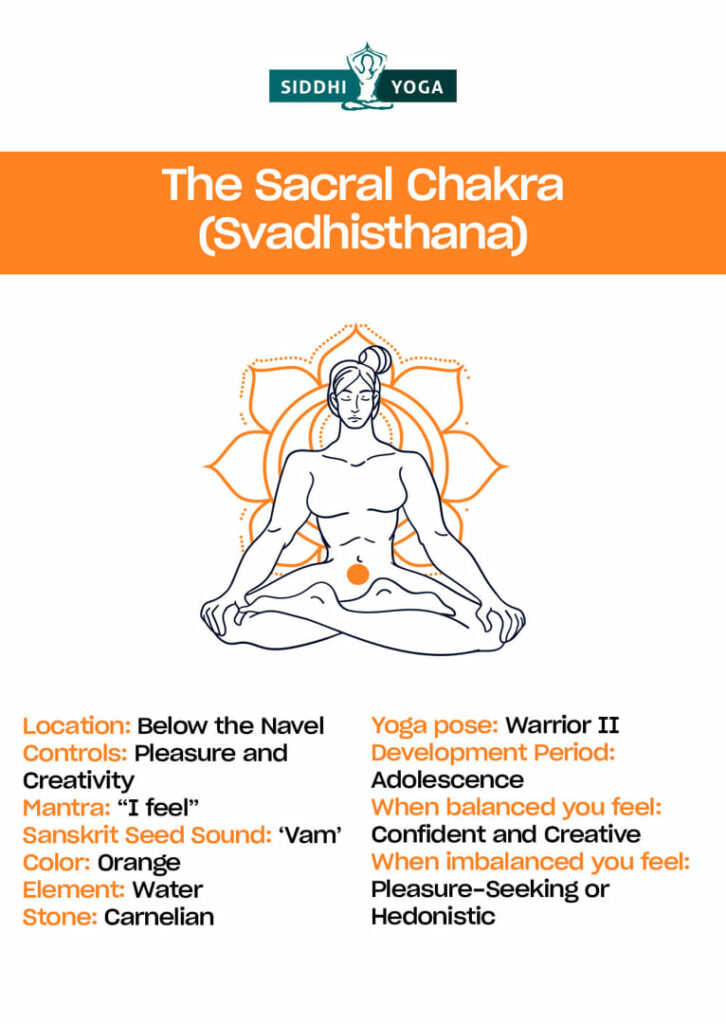
- Location: Below the Navel
- Controls: Pleasure and Creativity
- Mantra: “I feel”
- Sanskrit Seed Sound: ‘Vam’
- Color: Orange
- Element: Water
- Stone: Carnelian
- Yoga pose: Warrior II
- Development Period: Adolescence
- When balanced you feel: Confident and Creative
- When imbalanced you feel: Pleasure-Seeking or Hedonistic
The Solar Plexus Chakra (Manipura)
The Solar Plexus Chakra is the third chakra located in the upper abdomen. This chakra is associated with personal power, self-esteem, and confidence. It is the center of your will and determination and governs your ability to take action and make decisions.
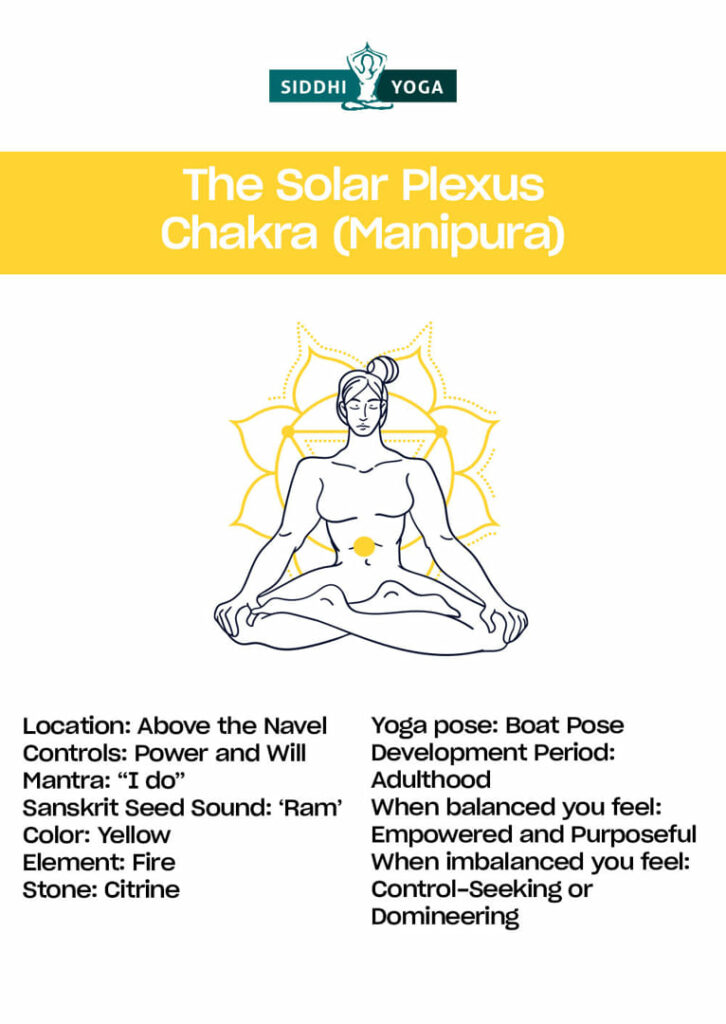
- Location: Above the Navel
- Controls: Power and Will
- Mantra: “I do”
- Sanskrit Seed Sound: ‘Ram’
- Color: Yellow
- Element: Fire
- Stone: Citrine
- Yoga pose: Boat Pose
- Development Period: Adulthood
- When balanced you feel: Empowered and Purposeful
- When imbalanced you feel: Control-Seeking or Domineering
The Heart Chakra (Anahata)
The Heart Chakra is the fourth chakra located in the center of the chest. This chakra is associated with love, compassion and forgiveness. It is the center of your emotions and affects your ability to give and receive love.
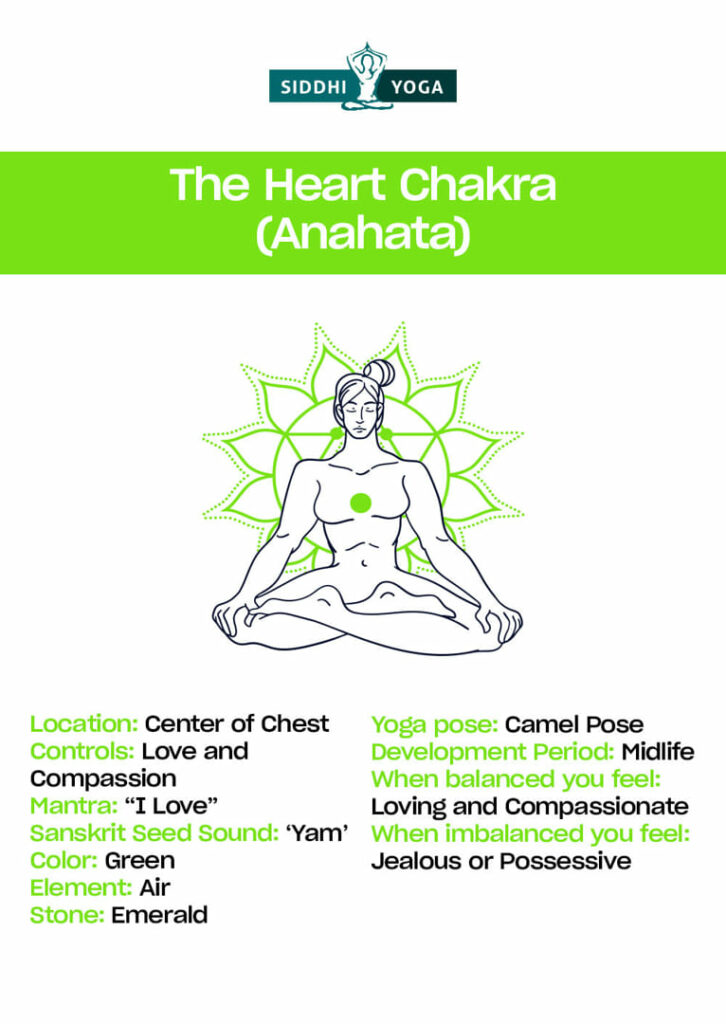
- Location: Center of Chest
- Controls: Love and Compassion
- Mantra: “I Love”
- Sanskrit Seed Sound: ‘Yam’
- Color: Green
- Element: Air
- Stone: Emerald
- Yoga pose: Camel Pose
- Development Period: Midlife
- When balanced you feel: Loving and Compassionate
- When imbalanced you feel: Jealous or Possessive
The Throat Chakra (Visuddha)
The Throat Chakra is the fifth chakra located in the throat area. This chakra is associated with communication, self-expression and truth. It is the center of your ability to speak your truth and express your emotions.
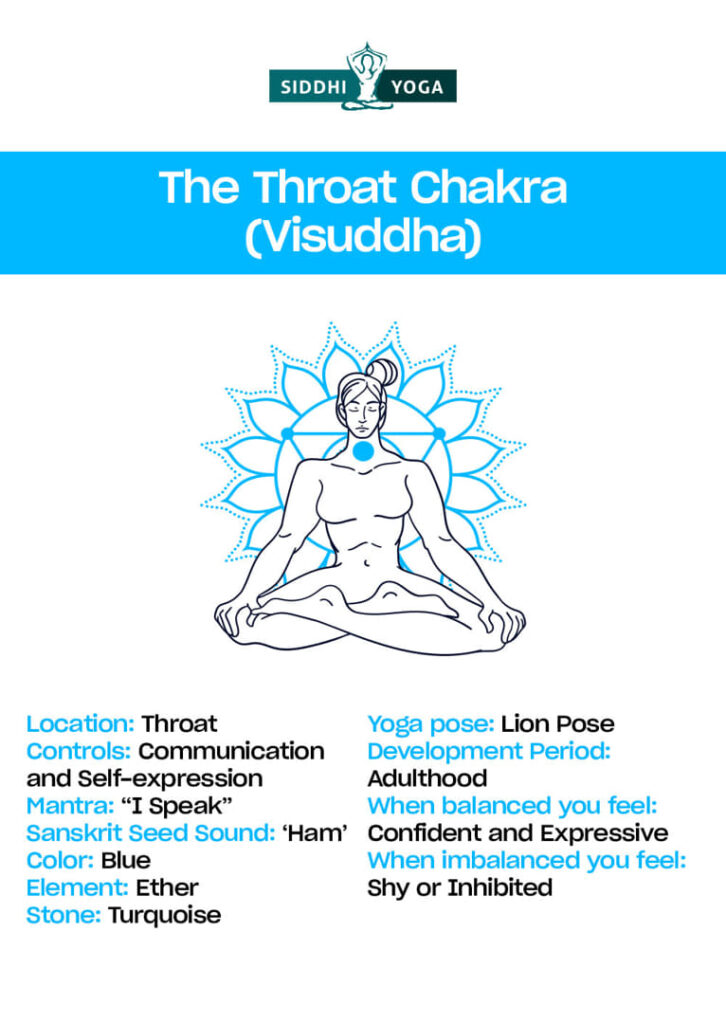
- Location: Throat
- Controls: Communication and Self-expression
- Mantra: “I Speak”
- Sanskrit Seed Sound: ‘Ham’
- Color: Blue
- Element: Ether
- Stone: Turquoise
- Yoga pose: Lion Pose
- Development Period: Adulthood
- When balanced you feel: Confident and Expressive
- When imbalanced you feel: Shy or Inhibited
The Third Eye Chakra (Ajna)
The Third Eye Chakra is the sixth chakra located between your eyebrows. This chakra is associated with intuition, imagination and wisdom. It is the center of your ability to see things clearly and make decisions based on intuition.

- Location: Centre of your Forehead
- Controls: Clarity and Wisdom
- Mantra: “I See”
- Sanskrit Seed Sound: ‘Aum’
- Color: Indigo
- Element: Light
- Stone: Lapis Lazuli
- Yoga pose: Child’s Pose
- Development Period: Adulthood
- When balanced you feel: Clear-minded and Decisive
- When imbalanced you feel: Scattered or Indecisive
The Crown Chakra (Sahasrara)
The Crown Chakra is the seventh chakra located at the top of the head. This chakra is associated with spirituality, enlightenment and cosmic consciousness. It is the center of your ability to connect with the divine and the source of all life.
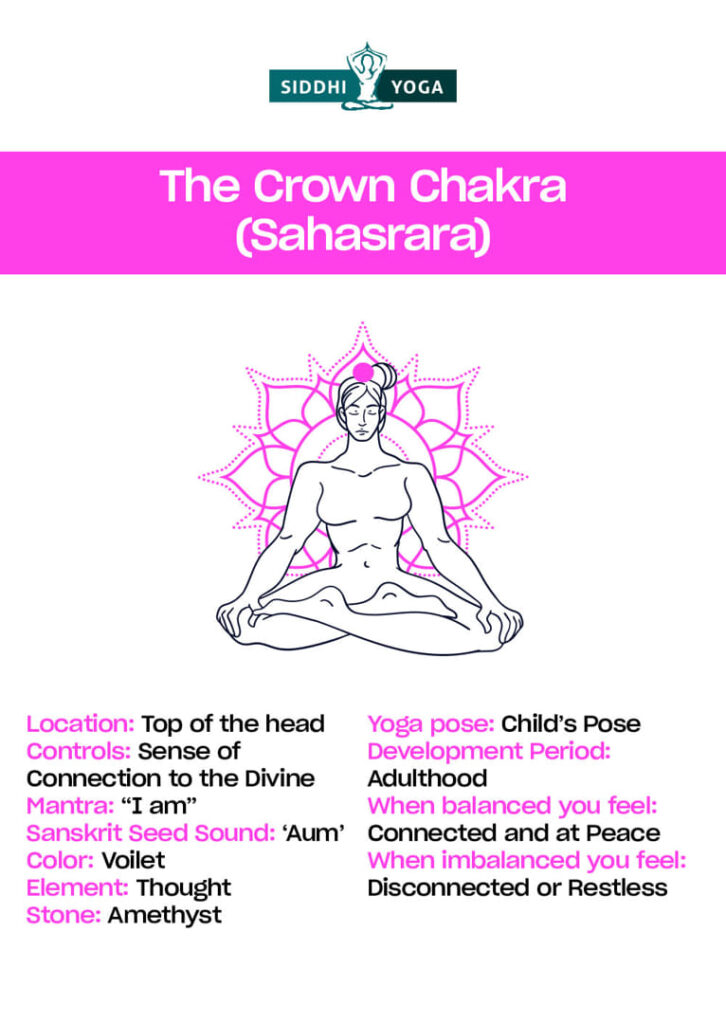
- Location: Top of the head
- Controls: Sense of Connection to the Divine
- Mantra: “I am”
- Sanskrit Seed Sound: ‘Aum’
- Color: Voilet
- Element: Thought
- Stone: Amethyst
- Yoga pose: Child’s Pose
- Development Period: Adulthood
- When balanced you feel: Connected and at Peace
- When imbalanced you feel: Disconnected or Restless
Importance of Chakras
While some people may view chakras as “woo-woo” or unimportant, the fact is that they are very relevant to our overall health and well-being. Here’s why:
The seven chakras are said to be responsible for our physical, mental and emotional health. If any of these chakras are out of balance, it can lead to physical, mental or emotional instability.
Each chakra is associated with a different area of your body. For example, the Root Chakra is related to your legs and feet, while the Heart Chakra is associated with the heart and lungs.
Chakras become imbalanced for various reasons, such as stress, trauma or negative emotions. When this happens, it is important to work on balancing the chakras to restore yourself to health and well-being.
There are various ways to balance the chakras, including yoga, meditation, aromatherapy, and crystal therapy.
Takeaway
The seven chakras are responsible for your physical, mental and emotional well-being. You feel healthy, happy, and wholesome when they are in balance. When your chakras are out of balance, you may feel physically, mentally or emotionally unbalanced.
Beginning Steps to Connect to Chakras
There are numerous ways to connect with your chakras. Some people meditate, do yoga or other forms of exercise, or use crystal therapy or other tools. Below are the basic steps to help you start:
1. Be aware of your chakras. Start by researching the chakra system and familiarising yourself with the location of each chakra in your body.
2. Start paying attention to your energy. Once you know the workings of your chakras, start noticing how you feel physically, emotionally, and mentally throughout the day. Try to identify which chakra or charkas may be out of balance.
3. Begin to connect with your chakras. There are many ways to do this, including meditation, breathwork, and crystal therapy.
4. Be patient and consistent. Connecting with your chakras does not happen instantaneously, so be patient and consistent with your practice. Don’t get discouraged if you don’t see results immediately. Keep at it and eventually, you will start to feel the benefits.
The Bottomline
The Chakra System is a complex network of energy centres throughout the body. They are responsible for maintaining your physical, mental, and spiritual well-being. There are seven main chakras, each with its unique meaning and purpose.
There are many ways to keep your chakras in balance. They include meditation, yoga, aromatherapy, crystal therapy and sound therapy. To explore how to balance your chakras, access our detailed course, ‘Understanding Chakras.’
